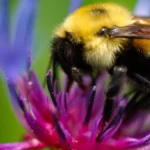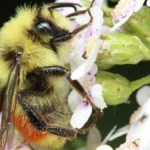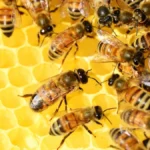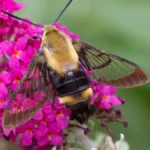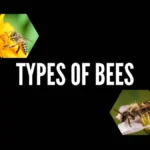In this article, we take a look at the difference between honey bees and bumblebees. This is quite an interesting set of questions to ask, as it shows how small problems with materials science can limit our options in life. In this case, bumblebees could not cross the equator without human help, but bees could. Read on to find out more about some of our favorite little pollinators and how they differ.
A Quick Overview Of Bees
There are a lot of species of bees out there. Some are solitary others are social, and then some are highly social. Solitary bees just work on their own as the name implies. Social bees form little nests of bees that work together and have some division of labor. Highly social bees like honeybees have a hugely complex social structure with the division of labor. This allows a complex society and a high level of productivity.
Bumblebees
Bumblebees have seasonal colonies. A queen starts the nest in spring. She forages, gathers pollen, starts the nest up and her daughters help her expand it to around 50 individuals by the end of summer. For a brief look at problems with bumblebee nests visit here.
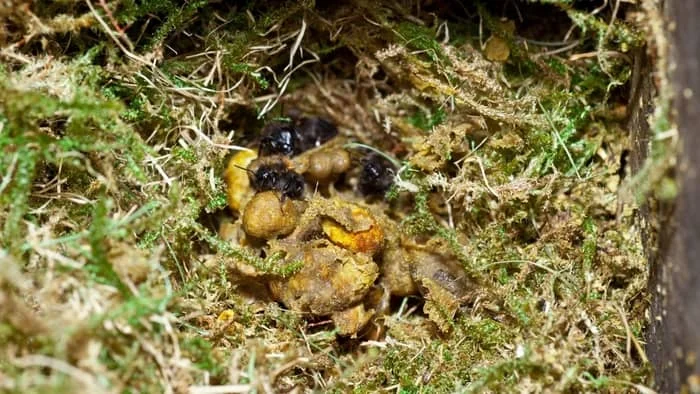
They build little wax honey pots to store some nectar for rainy days. And that takes us to bumblebee wax which is where we find a big difference between honey bees and bumblebees.
Bumble Bee Wax
Bumblebees normally make a type of wax that they use to make little honey pots. If someone were to ask you the question “Do bumblebees make honey?” you can confidently answer yes – but they store it in little pots, not combs. They also make a wax that melts at around 86°F to 104°F. As the season cools, the bumblebee colony comes to an end, young queens go out and hide in nooks and crannies, overwinter, and emerge in spring.
Honeybees
Honeybees have the ability to store enough honey to survive winter or a dry spell. They can consequently build up hive numbers of 50-60 or more thousand bees. Honeybees make wax comb that forms the structure of the hive.
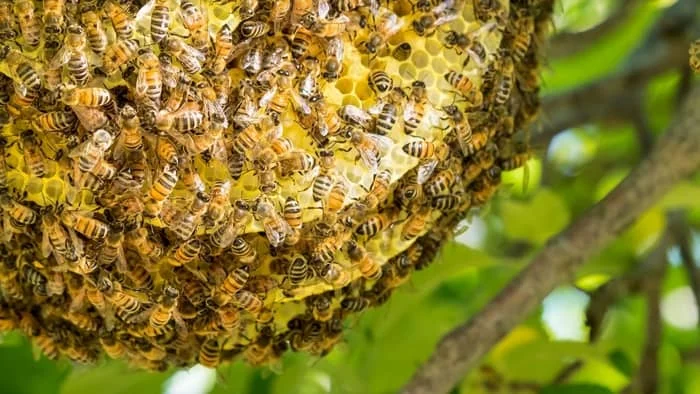
Beeswax
Beeswax enables the bees to process and store honey, rear brood, and process pollen in neat, organized, high-density rows of maximized storage space. This wax melts in the 145,4°F temperature range. Note this is considerably higher than bumblebees. The difference between honey bees and bumblebees is that the honeybee produces wax that can tolerate equatorial temperatures.
Bumblebees Vs Honeybees
The comparison of the broad group of bumblebees to the smaller group of honeybees is interesting.
Size
Bumblebees are generally bigger and bulkier than most honeybees. They are often very close to the aerodynamic limit of what can actually fly using their methods. They sort of bumble around as a result.
Pollination
When a bumblebee lands on a flower it “buzz pollinates” the flower. Honeybees are far more aerodynamically efficient and when they land on the flower there is hardly even a breeze. Hence honeybees pollinate by snuffling around in the flowers and moving pollen around with their bodies.
Navigation
Bumblebees leave the nest and use landmarks and memory and various cues to navigate. They do not fly long distances from the hive.
Honeybees use complex mathematical formulae and angles to the Sun to navigate and can navigate great distances. Honeybees however need to fly up to orientate. And herein lies an interesting twist to the tale.
Pollination In Greenhouses
Because a bumblebee flies using landmarks and visual cues, she can navigate inside a greenhouse. If you place a beehive in a greenhouse, the bees fly straight up to the roof of the greenhouse and then buzz against the greenhouse until they run out of energy and fall to the ground. A beehive in a greenhouse is a dead beehive in a greenhouse.
There are large industries that actually produce bumblebee colonies for greenhouse pollination. The small bumblebee nests are actually manufactured using advanced technology. Bumblebee farms even buy pollen from beekeepers for these systems.
What Bumblebees Mean To Your Diet
We have just covered how bumblebees can fly in greenhouses and shade cloth houses. This means that bumblebee colonies can be used to pollinate tomatoes, cucumbers, strawberries, melons, and various other crops that are grown in greenhouses. Without bumblebees, our diets further from the equator would just be more boring.
Bumblebees are small-scale specialist pollinators. They are experts at what they do, and, although small in number, their success rate on each flower visit is very high. Bumblebees are however limited by the fact that they cannot form large colonies. When it comes to bulk production, we need to hand it over to the industrialists.
What is Honeybees Mean To Your Diet
Honeybees are easy to manage for pollination. Feeding our bees cheap sugar and building up the hive strength is an important management tool. We can keep bees in warmer areas, and in spring, load hives on large trucks and move them thousands of miles to where they are needed for pollination. This allows us to produce industrial quantities of early flowering crops.
Almonds, apples, peaches, pears, berries, cherries are just a few examples of early flowering fruit crops that need honeybees. When it comes to field crops such as sunflowers, honeybees are very important to the production of this cornerstone crop. Sunflowers form one of the pillars of the global chicken and pork industries. Cooking oil and margarine would just not be the same without sunflowers.
Bees, Materials Science and The Equator
Bumblebees evolved in the Northern Hemisphere. Until recently they were not found in the Southern Hemisphere for one simple reason – their wax melts at the average daily temperature along the equator. The result is the bees could never get over the equator.
Recently some wombat of a human took these bees and introduced them to the Southern Hemisphere where they are becoming a pest in some areas.
Two-part Wax Mix – Think Bee Epoxy
Honeybees have a clever technology that they employ to make wax that melts at higher temperatures. They mix two components that then react. So the two base components are semi-liquid at the temperature in the hive – react these together and you have a mixture that is liquid at twice the temperature of the hive.
Because the honeybee has this ability to make wax that melts at high temperatures, it was able to cross the equator.
We hope this article has helped you see how the difference between honey bees and bumblebees allows us to produce more food with these pollinators. We need to save our pollinators, so share this widely.
Read more about: Do Yellow Jackets Kill Honeybees

Dr. Garth A. Cambray is a Canadian/South African entrepreneur and beekeeper with 28 years of experience in apiculture and specializes in adding value to honey. His Ph.D. research developed a new advanced continuous fermentation method for making mead that has resulted in a number of companies globally being able to access markets for mead. His company, Makana Meadery, exports honey mead to the USA where it is available to discerning connoisseurs. He has also developed technologies to commercially manufacture organic honey vinegar in Zambia for export globally. He holds a few patents globally in the ethanol industry and believes in technology and knowledge transfer for human development and environmental sustainability. One of his proudest achievements is the fact that the wind farm he started at one of his old apiary sites has essentially made his hometown carbon neutral.

